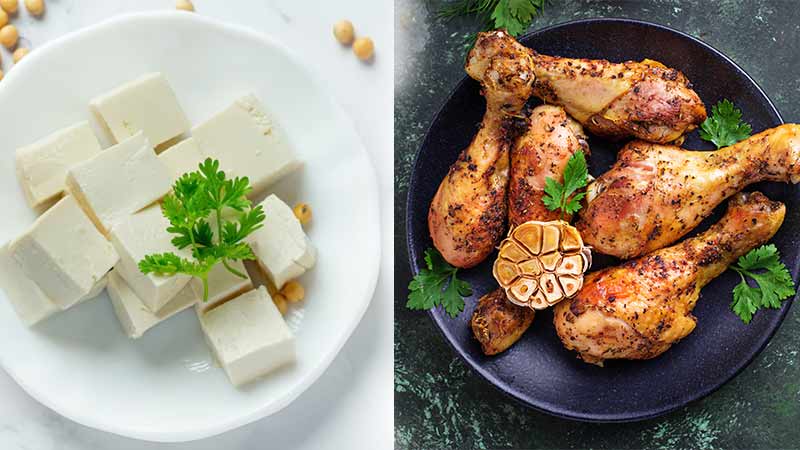Paneer v/s Chicken: A Nutritional, Environmental, And Cultural Comparison
- 24 months ago
Paneer and chicken are both popular ingredients in Indian cuisine, each with its unique flavor, texture, and nutritional profile. But which is better for your health, the environment, and cultural and ethical considerations?
In this article, we'll compare the nutritional benefits, environmental impact, taste, and cultural and ethical considerations of paneer and chicken to help you make an informed decision.
Nutritional Comparison
|
Nutrient |
Paneer (100g) |
Chicken Breast (100g) |
|
Protein |
19g |
22g |
|
Fat |
15g |
9g |
|
Carbohydrates |
12g |
0g |
|
Calories |
268kcal |
168kcal |
|
Calcium |
13mg |
11mg |
|
Iron |
0.9mg |
0.9mg |
|
Vitamin C |
0mg |
0mg |
|
Vitamin A |
80IU |
0IU |
|
Sodium |
18mg |
37mg |
- Paneer is a high-protein, low-carb option that is good for people with diabetes and those looking to lose weight. It is also rich in calcium and vitamin B6, essential for bone health and metabolism. (But it is high in saturated fat, which can increase the risk of heart disease if consumed in excess. Therefore, it's crucial to consume paneer in moderation and balance it with other low-fat sources of protein.)
- Chicken is a good source of lean protein for building and repairing muscles. It is also rich in niacin, which helps reduce the risk of heart disease. Additionally, chicken is a good source of other essential vitamins and minerals, including phosphorus, selenium, and vitamin B12.
Explore:
Environmental Comparison
- Paneer production requires a large amount of milk, which can have a significant impact on the environment, including greenhouse gas emissions and water consumption.
- Chicken production is associated with high greenhouse gas emissions, water consumption, and pollution.
If you're concerned about the environment, you may want to consider consuming paneer in moderation or choosing chicken from sustainable sources.
Taste and Versatility Comparison
- Paneer has a mild, creamy taste and a firm texture that holds up well in curries and other Indian dishes. It is also versatile and can be used in a variety of recipes, such as paneer tikka, paneer bhurji, and paneer makhani.
- Chicken has a savory taste and a tender texture that make it a popular ingredient in many cuisines, including Indian, Chinese, and Italian.
Explore:
Cultural and Ethical Comparison
- Paneer is a crucial ingredient in Indian cuisine and has cultural significance. It is also a good option for vegetarians and vegans who do not consume meat.
- Eating chicken raises ethical concerns, especially with factory farming and animal welfare.

Cooking Tips
- Paneer can be grilled, sautéed, or fried. It is often marinated in spices and yogurt to add flavor. It can also be crumbled and used as a substitute for cottage cheese or ricotta in recipes like lasagna or stuffed shells.
- Chicken may be prepared by grilling, roasting, baking, or sautéing and is often marinated in several spices and herbs to enhance its flavor. This versatile ingredient can be used in many dishes, such as curries, stir-fries, stews, soups, salads, sandwiches, and wraps.
Conclusion
In conclusion, paneer and chicken can be healthy options if you choose the correct preparation methods and consume them in moderation as part of a balanced diet. If you are looking for a high-protein, low-carb option, paneer may be a good choice for you. However, if you prefer the taste of chicken and are looking for a lean protein source, chicken may be a better option. Whatever you choose, enjoy your meal!








